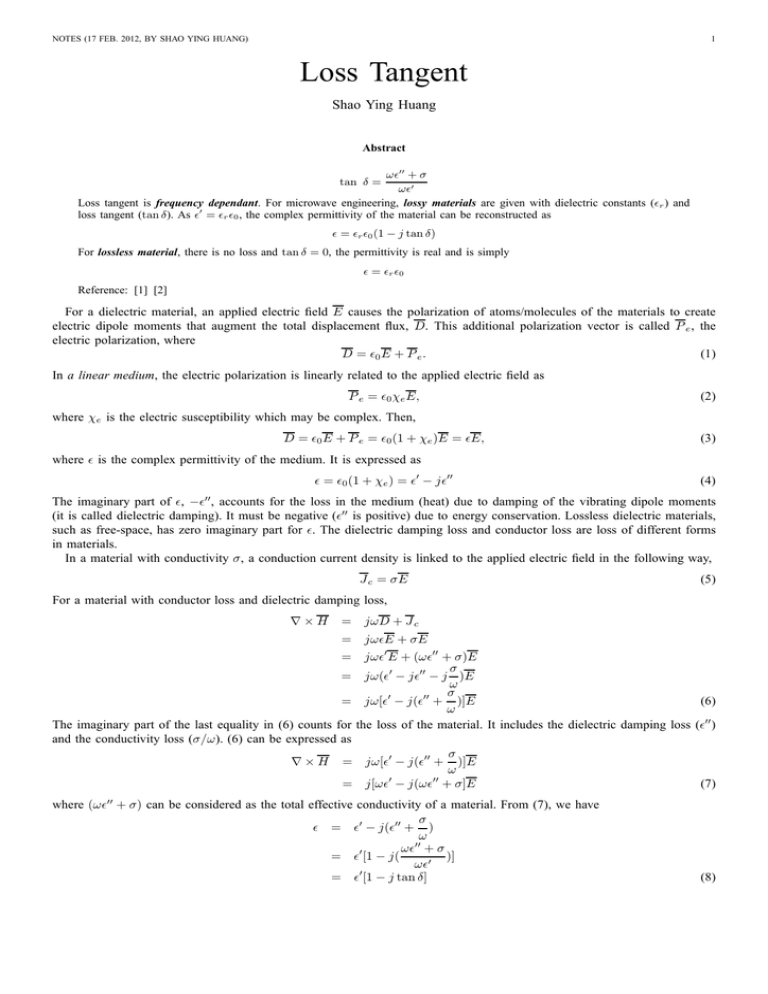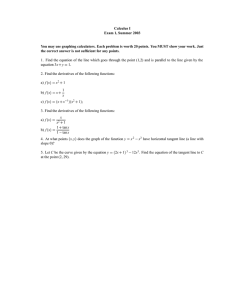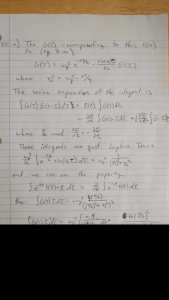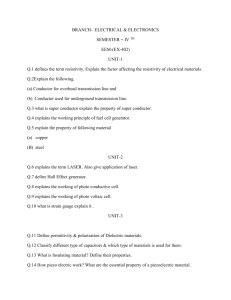Loss Tangent
advertisement

NOTES (17 FEB. 2012, BY SHAO YING HUANG) 1 Loss Tangent Shao Ying Huang Abstract ωǫ′′ + σ ωǫ′ Loss tangent is frequency dependant. For microwave engineering, lossy materials are given with dielectric constants (ǫr ) and loss tangent (tan δ). As ǫ′ = ǫr ǫ0 , the complex permittivity of the material can be reconstructed as tan δ = ǫ = ǫr ǫ0 (1 − j tan δ) For lossless material, there is no loss and tan δ = 0, the permittivity is real and is simply ǫ = ǫr ǫ0 Reference: [1] [2] For a dielectric material, an applied electric field E causes the polarization of atoms/molecules of the materials to create electric dipole moments that augment the total displacement flux, D. This additional polarization vector is called P e , the electric polarization, where D = ǫ0 E + P e . (1) In a linear medium, the electric polarization is linearly related to the applied electric field as P e = ǫ0 χe E, (2) where χe is the electric susceptibility which may be complex. Then, D = ǫ0 E + P e = ǫ0 (1 + χe )E = ǫE, (3) where ǫ is the complex permittivity of the medium. It is expressed as ǫ = ǫ0 (1 + χe ) = ǫ′ − jǫ′′ (4) The imaginary part of ǫ, −ǫ′′ , accounts for the loss in the medium (heat) due to damping of the vibrating dipole moments (it is called dielectric damping). It must be negative (ǫ′′ is positive) due to energy conservation. Lossless dielectric materials, such as free-space, has zero imaginary part for ǫ. The dielectric damping loss and conductor loss are loss of different forms in materials. In a material with conductivity σ, a conduction current density is linked to the applied electric field in the following way, J c = σE (5) For a material with conductor loss and dielectric damping loss, ∇×H = jωD + J c jωǫE + σE jωǫ′ E + (ωǫ′′ + σ)E σ = jω(ǫ′ − jǫ′′ − j )E ω σ (6) = jω[ǫ′ − j(ǫ′′ + )]E ω The imaginary part of the last equality in (6) counts for the loss of the material. It includes the dielectric damping loss (ǫ′′ ) and the conductivity loss (σ/ω). (6) can be expressed as σ ∇ × H = jω[ǫ′ − j(ǫ′′ + )]E ω = j[ωǫ′ − j(ωǫ′′ + σ]E (7) = = where (ωǫ′′ + σ) can be considered as the total effective conductivity of a material. From (7), we have σ ǫ = ǫ′ − j(ǫ′′ + ) ω ωǫ′′ + σ = ǫ′ [1 − j( )] ωǫ′ ′ = ǫ [1 − j tan δ] (8) NOTES (17 FEB. 2012, BY SHAO YING HUANG) 2 tan δ is called loss tangent. As shown in (8), loss tangent includes dielectric damping loss and conductivity loss of a material. The two type of loss are distinguishable to each other. Most importantly, it is frequency dependant. For microwave engineering, lossy materials are given with dielectric constants (ǫr ) and loss tangent. As ǫ′ = ǫr ǫ0 , the complex permittivity of the material can be reconstructed as ǫ = ǫr ǫ0 (1 − j tan δ) (9) For lossless material, there is no loss and tan δ = 0, the permittivity is real and is simply ǫ = ǫr ǫ0 (10) In some reference [2], the damping of the vibrating dipole moments is considered separately in the following way, ∇×H = jωD + J c + J f σ = jω(ǫ′ − j )E + J f ω (11) In the discussion in the reference in [2], the complex permittivity ǫ = ǫ′ (1 − j σ ) ωǫ′ does not include the dielectric damping loss. R EFERENCES [1] D. M. Pozar, Microwave Engineering, 3rd ed. New York: John Wiley & Sons, 1998. [2] J. A. Kong, Electromagnetic Wave Theory. EMW Publishing, 2008, p. 268. (12)




